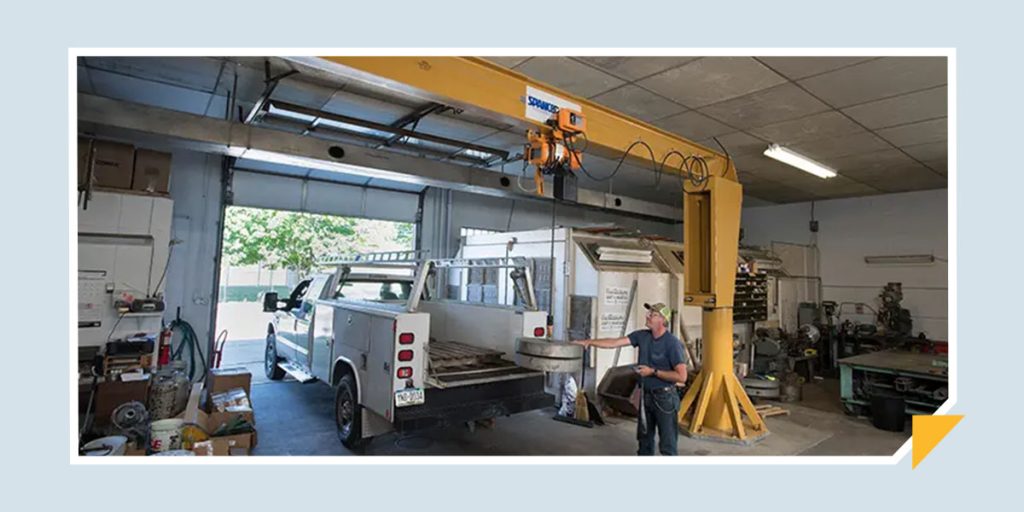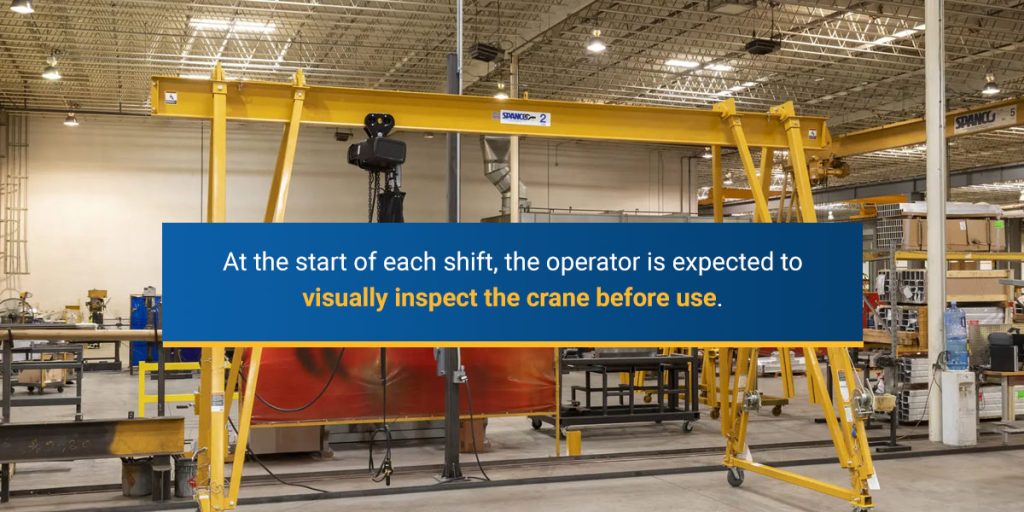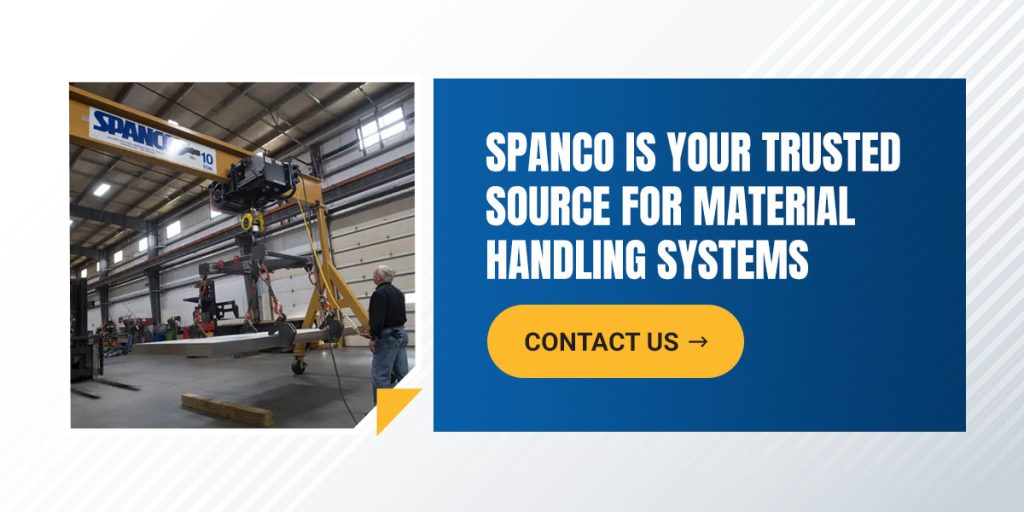
Overhead Crane Safety Tips and Advice
May 28, 2025
Overhead cranes are powerful pieces of equipment that offer heavy-lifting capabilities for numerous applications and industries. Operating heavy machinery requires significant training, safety knowledge, and responsibility to help prevent various accidents in the workplace. Equipment accidents can be dangerous and costly, potentially resulting in serious injuries and downtime.
As with all heavy machinery, crane operators must take precautions to keep material handling safer for everyone involved. It’s also crucial to pay attention to industry standards to promote safety and maintain compliance. Implementing the crane safety tips below can help create a safer workplace.
Functions and Operations of an Overhead Crane
An overhead crane is commonly found in industrial work environments. Some, like bridge cranes, are installed in the ceiling and have a traveling bridge between two parallel beams. Others, like industrial gantry cranes, are free-standing, supporting a beam with two legs and swivel casters. Depending on the application, every type of overhead crane is designed for specific functionality.
Overhead cranes are used to lift, move, and position heavy loads. Overhead cranes haul various heavy items, including machinery, hardware, and bulk materials. These cranes utilize electric wire ropes or chain hoists that can be lowered, attached, and raised. The loads are hooked to the ropes or chains with hoisting connections like electromagnets, hooks, and slings.
The crane operator is responsible for the function of the crane. This individual oversees load hookups and uses the crane’s controls to move the load. The operator must know overhead crane safety requirements to ensure the machine is used properly and safely.
General Safety Requirement Checklist
Regardless of the type of overhead crane used, crane operators and other workers in the area need to follow general safety guidelines. Overhead cranes present unique risks and hazards, requiring proper safety knowledge to ensure workers stay safe during crane operations. All crane operators must be trained and qualified to operate the crane.
Here are several general safety tips for working with or around overhead cranes.
1. Be Aware of Your Surroundings
One of the biggest safety tips surrounding overhead cranes is being aware of your surroundings. As the operator, you must have a clear view of the load to confirm overhead hoist safety and ensure you won’t be caught in potential pinch points when the load moves. Watch where you’re moving the load to ensure other people or things don’t get in the way while the load is moving. This is especially important to prevent workers from getting under the suspended load, which should always be avoided to prevent crush injuries if the load falls.
Verify the crane is equipped to hoist and transport the load, and watch for obstacles that could cause a collision when moving a load. Make sure the area where the load will be moving is wide enough to safely move the load and the space is clear of debris. If machinery is left unattended or other workers pass through the area, there’s an increased potential for a collision. The area should be kept clear when the crane is in operation to reduce the risk of hazards.
Other employees in the surrounding area should also be aware of crane operations. Ensure everyone working around a crane knows where they should be when it’s in operation and how to keep themselves and others safe.
2. Lift Loads Within the Crane’s Limits
Overhead crane manufacturers typically set a recommended weight limit, so crane operators know what Before lifting materials, ensure the load is within the maximum rated capacity, which should be clearly and visibly marked on the crane. Overhead crane manufacturers typically set a recommended weight limit, so crane operators know what the crane can safely lift. These weight limits are in place to ensure the crane is used as intended.
Only lift loads that are within a crane’s weight limit. Doing so helps prevent damage to the load, crane, and worker safety. When purchasing a crane, be sure to consider the maximum weight of your loads so you can find a crane that meets that capacity.
3. Perform Preventive Maintenance
Like any other heavy equipment, overhead cranes require preventive maintenance to stay in good condition. Preventive maintenance involves caring for the machine consistently to help prevent serious issues from developing. For example, preventive maintenance allows you to catch small issues like the need to replace a dirty filter or change the oil before they create significant problems that require costly repairs or replacements.
Keeping your equipment in optimal condition through preventive maintenance is much safer than using equipment that has been neglected.
4. Only Operate Cranes With Proper Training
Overhead cranes are considered heavy equipment, and operators must be adequately trained to safely use the crane. Additionally, operators need specific certifications or licenses to operate certain types of cranes legally. Certification requirements can vary from state to state and from employer to employer. Regardless of whether a certification is required, an overhead crane operator should be trained to safely use the machine to reduce potential risks.
5. Inspect the Crane Daily
The Occupational Safety and Health Administration (OSHA) requires operators to perform daily crane inspections. At the start of each shift, the operator is expected to visually inspect the crane before use. OSHA daily crane inspection requirements include checking all operating mechanisms for damage and ensuring the parts operate as they should.

Follow a daily safety inspection sheet that includes a checklist before, during, and after each crane use. Some components to check include:
- Air and hydraulic systems
- Hoisting connections
- Electrical apparatus
- Ground conditions
- Safety devices
Gantry Crane Safety
Because gantry cranes differ slightly from some overhead cranes, they have different safety specifications. These cranes are free-standing, so the gantry crane installation process is much simpler than that of some overhead cranes.
If you’re building the gantry, make sure it’s straight and sits on level ground. Check ground conditions to be sure they’re stable enough to support the weight of your crane plus the weight of the loads you’ll be moving. If one leg is longer than the other, sits at a different angle or sinks into soft ground, the crane’s lift capacity will be affected and may create hazardous conditions. Plan and lay out the jobsite, allowing space for emergency vehicles to pass if necessary and avoiding working near power lines.
Additionally, be sure to exercise extreme caution with the legs on wheels. While swivel casters are convenient, they can roll before you’re ready. Use breaks or stop blocks to prevent the crane from moving while attaching or detaching a load from the crane. When rolling the gantry crane, there is a risk of the load swinging while you move the crane. A swinging load puts unnecessary stress on your crane and can cause significant damage or injury if it hits something.
Be sure to consider additional aspects associated with overhead crane operation safety in your unique work environment to ensure everyone’s safety.
MMA-MHI: The Standards of Overhead Crane Safety
When selecting overhead crane equipment for your facility, following Monorail Manufacturers Association (MMA) standards helps ensure equipment meets current safety standards. In particular, you can maintain compliance with MH27.1 and MH27.2 specifications.
The MMA is a trade association affiliated with the Material Handling Industry and is a leading authority in overhead cranes and material handling. The MMA works closely with OSHA and other safety organizations to promote and ensure the safe use of overhead track systems in all material handling industries. The MMA approval process ensures that all manufactured equipment with the MMA certification logo meets the latest ANSI standards.
Leveraging member expertise, the MMA continues creating and issuing specifications aimed at enhancing overhead crane safety.
Our Material Handling Overhead Crane Solutions
High-quality equipment is the best way to supplement your material handling safety efforts. Spanco offers pre-engineered overhead cranes, which can be customized to meet your specific application’s needs. We provide the following types of material handling cranes to cover a multitude of applications:
- Workstation Overhead Bridge Cranes
- Sturdy Mobile Gantry Cranes
- Articulating and Mast-Style Jib Cranes
- Monorail Material Handling Systems
- Industrial Tripods
Our material handling overhead crane systems use a movable hoist to raise and transfer heavy items laterally through an overhead space. They’re ideal for tasks such as:
- Moving equipment, tools, and supplies around the facility.
- Retrieving goods from storage.
- Loading and unloading materials from a transfer truck.
- Moving parts through an assembly line.

Spanco Is Your Trusted Source for Material Handling Systems
Overhead cranes need to be high-quality and durable to adequately support your loads. At Spanco, we design our cranes with high-quality, durable components. We want your jobsite to be safer and efficient, and that’s why you can rely on us for material handling solutions that manage your heavy loads, freeing up your employees to work on other tasks.
Browse our selection of gantry cranes and other overhead cranes, or contact our team for more information.
Categories
Share this post
Contact us
Looking for the perfect fall protection equipment? Let us help!